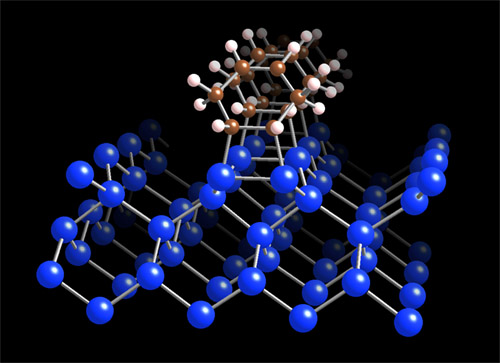 |
Japanese |
Tsuneyuki Research Group |
Research
"Property of organic molecules well arranged on a semi-conductor surface"
On a semiconductor surface, there are regularly arranged atomic orbitals called "dangling bonds". They are sticking outside and have chemical reactivity. If we can build a well designed layer of organic molecules by self-assemble structure based on such dangling bonds, it will give a clue to novel interfaces with various function toward molecular devices and chemical reaction field for special purposes. Tsuneyuki group and our collaborator Yoshinobu group (ISSP) are investigating silicon surfaces,
on which cyclohexene or 1,4-cyclohexadiene molecules (they have six membered carbon ring and one or two π-orbitals, respectively) are regularly arranged,
by experimental methods such as STM (scanning tunneling microscope) and other spectroscopy methods as well as computational methods based on density functional theory.
Tsuneyuki group and our collaborator Yoshinobu group (ISSP) are investigating silicon surfaces,
on which cyclohexene or 1,4-cyclohexadiene molecules (they have six membered carbon ring and one or two π-orbitals, respectively) are regularly arranged,
by experimental methods such as STM (scanning tunneling microscope) and other spectroscopy methods as well as computational methods based on density functional theory.We have so far clarified the coverage dependence of chemisorption pattern and the existence of different conformations like a relation between "boat type" and "chair type" on a surface. And now, we are especially interested in further organic chemical reaction of these systems. Since just one π-orbital is used for chemisorption with substrate, 1,4-cyclohexadiene molecule, which originally has two π-orbitals, still leaves one π-orbital remaining. Organic chemistry of these molecules in a liquid phase has been well studied, but when they are regularly fixed on a two-dimensional surface, another selectivity of chemical reaction different from that in a liquid phase is expected.
[1] K.Akagi and S.Tsuneyuki, "Unsaturated cyclic-hydrocarbon molecules on a Si(001) surface - A first-principles approach -" , Surf. Sci. 493, 131 (2001).
< BACK >
